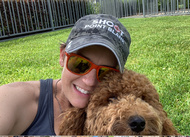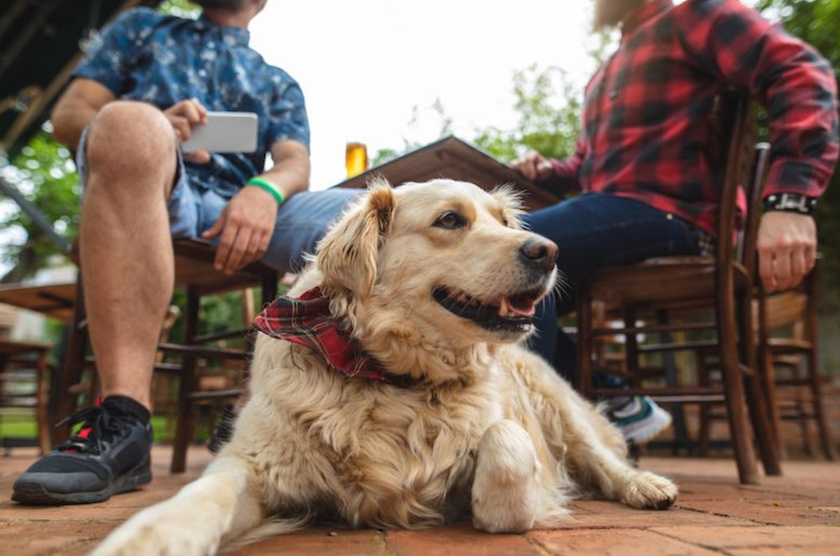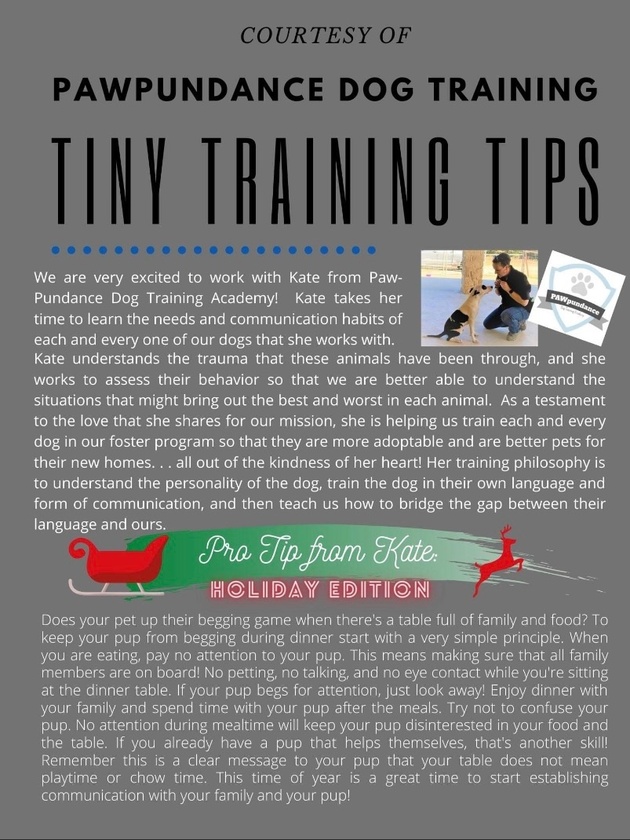
It’s ok! We’re here to help. We speak a little dog and can help translate for both of you. It’s probably just a miscommunication! And we are here to help get you both speaking the same language! Woof!
Connect with the PAWpundance training team and other members of the dog community to discuss better ways to communicate with your furry house guest.
**To get started USE code: TRIAL1month **
Throwing it Down or Throwing a Down
What does it mean to throw a behavior, like a down? We present a dog with a reward. Then we ask the dog to guess what activity could we possibly be asking for. It becomes like a game of charades. So we teach the pups which are our favorite behaviors for positive attentions with rewards like attention, treats, snuggles and toys. We help them learn the behaviors that we do not like by turning away our attention, and not giving treats, snuggles or toys.
Why is "throwing" a behavior important? We want the pups to display a certain amount of curiosity. If the pups don't have this curiosity, it can show possible abuse in the past. If a pup, in the past, was trying to get attention and got punitive response for his attempts then he might be hesitant to make anymore attempts. The level of attempts can give two factors: the pups natural shyness and the intensity of the punitive responses. So if the pup is excessively skittish, she might have been exposed to abuse-level punitive "training". Sometimes the pups exposed to this time of "discipline" will have a "freeze" style of response rather than a skittish behavior. They have learned that their "ideas" always end up in a form of abuse or "discipline" so they stay frozen until given further instructions. None of this is healthy for the pups or our relationship with the dogs.
We would rather work with a very creative pup and to see what kind of ideas the dog can produce. To do this, we have to understand that not all of the ideas - in fact most - are not what we want. So we need to have a communication that does not shame the pup when the ideas are not correct. Just like a game of charades, we want ideas to keep flowing until we get the correct one! Have you ever been at a meeting with co-workers and every idea that is generated one person shuts down before it can be fully developed. In the beginning stages, we try to create ideas and later we discuss their merit. But when someone cuts the process short and brings negativity to the initial stages, it's hard to get any momentum and the whole team feels it. It's the same with your pup! We want to develop their ideas before we shut them down.
How do we do this? When the pups are giving us the behaviors that we haven't asked for - start by acknowledging that they aren't wrong. They just aren't what you want right now. But you might it later. And if you punish the behavior, you won't be able to get it. The best advice I have is to smile. When your pup throws a different behavior, turn your head and look away. If they keep trying then use that winning smile of your! Smile and encourage by saying, "keep going!" (Save the phrase, "good boy/girl" for the win.) Then when you get a behavior, if it's wrong: drop to a neutral face, turn just your face and look away. Think Napoleon Dynamite. Take a moment and exhale. Then bring back the glowing smile and ask again for the behavior! And this time try to set your pup up for success! If it's a down, lean into a bit more. If it's a sit, straighten up a bit. Maybe add a hand gesture. Always try to control the environment to set your pup up for a win!
We like to see pups throwing behaviors/trying new stuff, not only for the creativity but it shows their confidence. Watching a pup come up with different ideas is fun for us and it's fun for the pup. When we train in this way, the pups don't feel like it's a regimented workout. They are exploring and having fun. This is not stifling and punishing. And we are reinforcing the requested behaviors with attention, love, toys and food - all the best rewards.
In this example, we are working a "down" specifically. There are many times this can be used. If you are having trouble "shaping" a down or if you want to time the down for example.
In the example of "shaping" the down, this just means the traditional way teach the down isn't working. Normally we get the pup into a sit. Then we slowly we lure the pup to bring their nose forward. Eventually we bring their nose forward and down enough that one foot walks forward and then the other. Eventually their whole body plops down into a laying down position. Not all dogs go for this.
There are also times where you might what calm behavior. And a down is a great way to "ask" for calm behavior. If you have a dog that gets very excited when you have guest entering your home, having your pup greeting them with a down is a good way to "time" a down. In this way, we as for a down at a specific time and this time or situation is a cue for the behavior.
I really like the last situation. I have taught my big pups to "throw" a down when they want attention from us or guests. They do this when they want treats and they have had this so reinforced that it's their go-to move. Any time they want something they throw themselves into a down. I like to say it's reverse jumping. It's still excitable behavior and we still have a ways to go for them to know exactly what to do in every situation. They are still young pups and we have to be consistent over time for them to understand every situation. That's why older pups that live with us are so polite. In the meantime, I will take this reverse jumping any day to a dog throwing themselves on me.
My pups have even learned a "relax" which is to put their nose on the ground and wait for rewards. This is the beginning of calm, impulse control behavior. When I am in the kitchen cooking, and I see my pups "throwing" calm behavior like this, I'm careful to reward with attention. I worked with a pup named Lulu and she was my first to learn "relax". She did not like having people bend over her. She is a rescue pup and possibly something in her past made her sensitive to this in humans. However, most pups agree with Lulu. They don't like it when humans hover over them. The reaction of most pups is to gain height. So their natural reaction is to gain height and jump. This forces the humans to step back and stand up. Most of us think we are in some kind of control and want to train our dogs to behave otherwise. So with Lulu, I worked to show her that humans are ok. We aren't there to harm her. I did many exercises with her where she was rewarded for throwing a down instead of jumping when I bent over her. The cue became me bending over her and she was rewarded. With a dog like Lulu, it was as much a behavior modification as training to help her understand that we weren't there to hurt her. We just want to give her love when we bend over her. I also worked with her caregivers to help them understand how difficult it can be for dogs to understand the way we move. Together they learned each other's body language.
Eventually the "throwing" part starts to fade and there is a clear cue and response. Once the behavior has been clearly requested and rewarded a number of times, the dog begins to know what to do and quickly responds. The pup no longer has to guess or throw behavior and sees the cue or signal for the behavior and quickly responds. After which the team of pup and human-caregiver can work towards "stimulation-control". This is a fancy term used in behavior sciences. It simply means the whole process is down pat. There is no confusion. When we ask for a behavior (ex sit) the pup quickly responds with the correct activity and no confusion.
In conclusion, throwing behaviors is very important in training. It shows the creativity and confidence our pups. It lets them explore and enjoy their session so it feels more like play. We have to be very patient and smile. Instead of being frustrated at "wrong answers", we need to delight in our pups wide range of ideas. Eventually we will get the behavior we want. And we will reinforce with consistency. Then we can have a clear cue and the "throwing" of behaviors will fade. It will be a clear cue and ... boom down... or whatever requested behavior you are requesting.
We can use puzzles and other activities to assess a pups ability to "throw" behavior. We can see how pups like Lulu respond and work with their prior experiences to overcome fears. We can help them to "throw" behavior that will end in a WIN! And we alway like to help set our pups up for a Win!
Welcome to PAWpundance Dog Training Academy on Locals.com!
We’re thrilled that you’ve joined our community! PAWpundance is a place for positive, dog-loving people to come together, share experiences, and help each other grow. Locals offers an “ad-free experience,” so even a small contribution helps support our tech and keeps our community thriving.
We want to see your furbabies!
We’re here to assist with any questions you may have about training, behavior, and more. At PAWpundance, we believe in blending knowledge with a bit of fun—expect plenty of paws, puns, and maybe even a dance or two! Together, let’s enjoy some laughs and build stronger relationships with our pups.
Our Philosophy:
We’ve invited another species to live in our homes, and our dogs are much more than accessories; they’re our guests. They don’t speak our language, and like in the movie E.T., we don’t want to be the intimidating figures trying to coerce a scared, confused being. Instead, we want to be like ...
Eye Contact, Eye Contact, Eye Contact!
Reward every glance. Start by reinforcing brief glances, then encourage your pup to hold your gaze a bit longer. Gradually phase out your part of the eye contact—your pup will learn to watch you and adapt to your movements naturally. This approach helps them learn to walk with you without relying on leash cues.
Remember, the leash is purely for safety—not for communication.
Take a look at this video with Meghan and Buckee. Buckee is watching Meghan closely, and she rewards him by making eye contact, smiling, and offering treats. Meghan also looks forward occasionally, teaching Buckee to walk with her in sync.
Notice that Buckee is a reactive pup, so the leash is essential for safety, especially if he responds to something unexpectedly. However, it’s only used for physical control when necessary. When Buckee refocuses, Meghan reestablishes instructional control, and they continue their walk together. She does a fantastic job of engaging with him! In ...
Loose-Leash Walking Tip:
Where you reward makes a big difference! Try using the hand on the same side as your dog when giving treats or praise.
When you reach across your body to reward with the opposite hand, it draws your dog’s nose in front of you, encouraging them to move ahead and potentially start pulling.
In the video of Meghan and Domino, Meghan holds the leash with her left hand while Domino walks on her right. She rewards him by petting and giving treats with her right hand. This keeps Domino walking by her side on a loose leash, rather than in front, pulling her along.
Next time you’re out walking with your pup, try rewarding with the hand on the same side as your dog.
https://twitter.com/wholedogjournal/status/1295508215740932098?s=21
How to teach you pup to be a good dining companion! What a great skill!

https://twitter.com/wholedogjournal/status/1292609106637987840?s=21
This is about counter-surfers, but I love the description of trying to shame dogs. This author, Pat Miller helped me understand this concept in her book the Power of Positive Dog Training.
If you’re still on Twitter, the Whole Dog Journal is a great group to follow. Lots of fantastic info!













